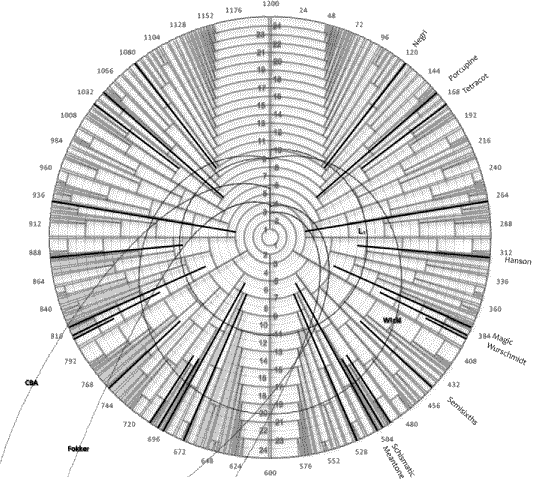

Moment of Symmetry ScalesThe recognisably diatonic scales produced by the generators alpha = 1200 cents and 685.71When the generator is far from 700 cents, the corresponding MOS scales are very different from the seven note diatonic scale. For example, when beta approximates 380 cents, the MOS scale has three large steps and seven small steps (abbreviated MOS:3+7). Because the scalic structure is different from the familiar diatonic structure, the major and minor triads embedded within it are connected in different (non-familiar) ways. For example, in the diatonic scale the minor second connects 5/4 to 4/3 (and so is a voice-leading interval that connects chords whose roots differ by by a fifth. In contrast, in the MOS:3+7 scale, the minor second connects 6/5 to 5/4 (and so is a voice-leading interval that connects parallel major and minor triads. Note how the in the MOS:3+7 scale this latter connective interval is within the scale, while in the diatonic scale it is not; these sorts of differences open up the possibility for completely novel types of tonal functionality and provide virgin territory for the adventurous composer and performer. 
The relationship between MOS scales and layouts is illustrated by showing the maximum cardinality 2-D systems for a selection of layouts hosted on an approximately hexagonal button-lattice, with a Wicki keyboard layout having a diameter of ten buttons. The angular position around the circle corresponds to the beta value in cents (alpha is fixed at 1200 cents). The grey radial lines show the beta-tunings that give n-TETs and their cardinality n is indicated by the ring at which each line starts. The arcs between the n-TETs represent the valid tuning ranges of all MOS scales, with cardinality indicated by the ring on which they are drawn. The bold radial lines indicate optimal tunings for various 5-limit regular temperaments, and the ring from which each line starts shows the lowest cardinality scale within which every scale note is a member of a full major or minor triad. The TransFormSynth lets you explore many of these tunings in a unified and simple manner. |
©2008 William Sethares; site design by Anthony Prechtl |